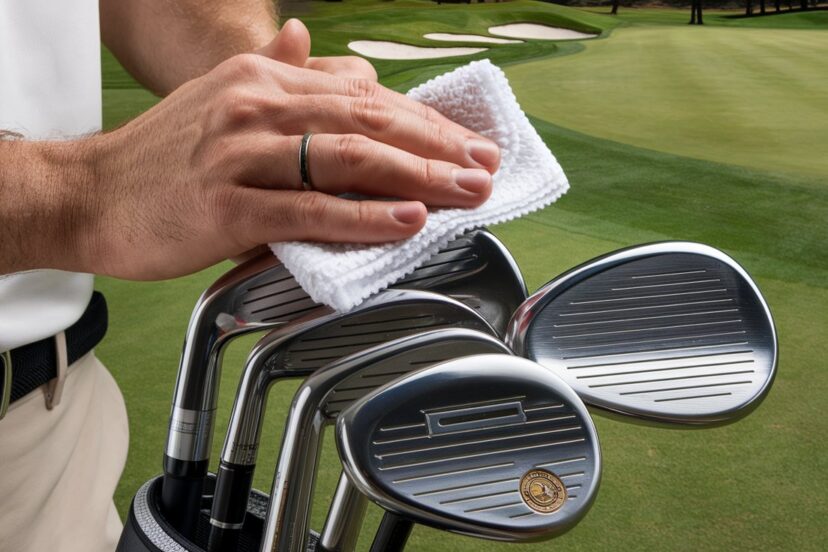Golf Club Cleaners: Maintain Your Gear Like a Pro
*We may earn a commission for purchases made using our links. Please see our disclosure to learn more.
The moment I first realized the importance of clean golf clubs happened on a crisp autumn morning at my local course. After months of playing with increasingly dirty clubs, I decided to give them a proper cleaning with a good golf club cleaner before my weekend round. The difference was immediate and undeniable. My irons suddenly bit into the greens with renewed grip, my wedges generated that satisfying spin again, and even my putts rolled truer on the green. That simple cleaning session didn’t just improve my equipment – it elevated my entire game.
For many golfers, clubs are a significant investment, yet we often neglect the simple maintenance that can extend their life and improve performance. Whether you’re a weekend warrior or a serious player, keeping your clubs clean with quality golf club cleaners isn’t just about aesthetics – it’s about protecting your investment and optimizing your performance on the course.
In this comprehensive guide, I’ll walk you through everything I’ve learned about golf club cleaning over my 15 years in the game – from the impact dirty clubs have on your shots to the best golf club cleaners and cleaning techniques. I’ll share my personal journey of discovering how proper club maintenance became a game-changer for my golf experience, recommend products that genuinely work, and provide practical advice you can implement regardless of your skill level.
Key Takeaways
- Performance Impact: Clean clubs provide better ball contact, increased spin, and more consistent shots
- Equipment Longevity: Regular cleaning prevents rust, corrosion, and premature wear of club faces
- Cleaning Frequency: Clubs should be wiped down after every round and deep cleaned every 3-5 rounds
- Essential Tools: A quality golf club cleaner, brush, towel, and mild soap are the foundations of proper club care
- Prevention Habits: Developing simple routines during play can minimize buildup and make cleaning easier
“Taking care of your golf clubs is just as important as learning how to use them properly.”
– Tiger Woods, 15-time major champion
Recommended Golf Club Cleaners
Before diving deeper into cleaning techniques, here are four excellent golf club cleaners currently available on Amazon that I’ve personally tested or researched thoroughly:
Frogger BrushPro Golf Club Cleaner
The Frogger BrushPro Golf Club Cleaner is a must-have accessory for any serious golfer. Designed with an ergonomic grip and a sturdy 2.5-foot retractable cord, this award-winning brush features a patented combination of phosphorous bronze and nylon bristles to effectively clean your clubs without causing damage. With fully replaceable parts, including an extra 100% nylon brush head and groove cleaner, the BrushPro offers long-lasting performance. Frogger’s passion for the game shines through in every detail, helping you maintain cleaner clubs for stronger, more accurate shots.
A dual-sided golf club brush with a retractable 2.5-foot cord and ergonomic grip. Features durable phosphorous bronze and nylon bristles for effective cleaning of different club types. Includes a fold-out groove cleaner and replaceable brush heads.
- Ergonomic Grip: Comfortable to hold and easy to use during rounds.
- Replaceable Parts: Extra brush head and replaceable groove cleaner extend product life.
- Retractable Cord: 2.5-foot cord offers convenience without worrying about losing the brush.
- Price: Slightly more expensive compared to basic golf brushes.
- Bulkier Size: May feel a bit large for minimalists.
- Color Options: Limited color variations depending on availability.
HIFROM Golf Accessories Set
The HIFROM Golf Accessories Set is a must-have for golf lovers looking to maintain peak club performance. This set includes a high-grade golf club groove sharpener with six heads (U-shaped and V-shaped) to help improve backspin and ball control, plus a dual-sided golf brush with nylon and wire bristles. Built from precision vacuum heat-treated steel, the groove sharpener offers superior durability, while the 2-foot retractable cord and carabiner make the brush easy to carry. Designed for a secure, non-slip grip, this set is perfect for keeping your clubs — and your game — in top form.
Budget-friendly set with a groove sharpener and dual-sided brush in one kit. Features durable vacuum heat-treated steel, nylon and wire bristles, and a retractable cord for easy access.
- Complete Set: Includes both a groove sharpener and a club brush for full club maintenance.
- Durable Construction: Made from high-grade, vacuum heat-treated steel for long-lasting use.
- Easy to Carry: Retractable zip-line and carabiner make attachment to your golf bag simple.
- Smaller Size: Brush may feel small for those preferring a larger handle.
- Wire Bristles: Wire side can be too harsh if not used carefully.
- Limited Color Options: Color availability can vary.
Xintan Golf Club Cleaner Washer
The 10L0L Golf Cart Ball Washer and Club Cleaner Kit offers a convenient, all-in-one solution for keeping your clubs and balls spotless on the course. Featuring durable bristles, separate cleaning tanks, and a smart single drain system, this kit is easy to use and maintain. It includes a pre-drilled mounting base for stable installation on most golf carts, ensuring your cleaning tools stay secure during every round. Built for performance and ease, it's an essential upgrade for serious golfers.
Mounted golf ball and club washer for carts. Features separate cleaning tanks, durable bristles, and an easy-drain system. Sturdy, pre-drilled design for secure installation.
- Powerful Cleaning: Durable bristles and separate tanks make it easy to thoroughly clean both clubs and balls.
- Simple Drain System: Quick and hassle-free emptying with a garden hose connection.
- Stable Mounting: Integrated base and sturdy bracket keep the washer securely attached to your golf cart.
- Initial Stiffness: Bristles may feel hard during first few uses.
- Installation Required: Some users may find mounting slightly time-consuming.
- Size: May feel bulky on smaller carts.
HOUQSWA Retractable Golf Club Brush
The CHAMPKEY Premium Polyurethane Golf Club Brush is designed for golfers who demand power and precision in their club cleaning. Featuring an oversized brush head with nylon and wire bristles, this brush delivers superior cleaning performance while offering a longer lifespan. The ergonomic polyurethane handle reduces hand pressure, providing a comfortable grip even in tough conditions. Additionally, the retractable groove cleaner ensures safe and efficient cleaning of individual grooves, keeping your clubs in peak condition.
Premium golf club brush with oversized head, retractable groove cleaner, and ergonomic polyurethane grip. Designed for powerful cleaning and maximum comfort.
- Oversized Brush Head: Larger bristles provide more powerful cleaning and extended durability.
- Ergonomic Grip: Polyurethane handle minimizes hand strain and improves control.
- Retractable Groove Cleaner: Offers safe and secure cleaning of club grooves with easy storage.
- Brush Size: Larger brush head may not fit easily in smaller storage compartments.
- Initial Stiffness: Wire bristles might feel stiff when first used.
- Retractable Cleaner: May require extra care to ensure smooth retraction.
My Journey into Better Golf Club Maintenance
Looking back, I can divide my golfing life into two chapters: before and after I discovered proper club cleaning. For years, I was the typical amateur who wiped my clubs with a towel and considered that enough. My bag contained irons with grass-filled grooves, wedges with residue, and a driver that had lost its shine months ago.
“Clubs are meant to get dirty,” I’d tell myself. “That’s part of the game.” Little did I know how much this neglect affected both performance and equipment longevity.
The turning point came after a round with Sam, a retired PGA teaching professional. He noticed me struggling with approach shots and asked to see my pitching wedge. After inspecting the grooves, he said, “Your technique is fine, but these grooves might as well not exist anymore.” He explained that grooves are designed to channel moisture and create friction – impossible when they’re clogged with dirt.
That afternoon, Sam showed me how to properly clean my clubs, and I was shocked at the grime that came off even with gentle cleaning. The difference in performance was immediate. My wedges gripped the greens again, and shots that had been sliding off the club face now connected with crispness.
Since that day, I’ve made cleaning my clubs a priority, regularly using effective golf club cleaners to maintain their performance. Proper maintenance doesn’t just protect your investment – it enhances your game.
The Science Behind Clean Golf Clubs
What I initially thought was superstition turned out to be simple physics. Clean grooves on irons and wedges allow air and moisture to escape at impact, creating more friction between the ball and clubface. This increased friction translates directly into improved spin control – critical for stopping the ball on greens or shaping shots intentionally.
For woods and drivers, clean clubfaces ensure consistent ball striking. Even a thin layer of dirt or grass residue can affect how the ball compresses against the face, potentially robbing you of valuable distance or introducing unwanted side spin.
Research by equipment manufacturers has shown that dirty grooves can reduce spin rates by up to 50% – a staggering number that explains why many shots that should check up end up rolling well past their target. Additionally, for players using urethane-covered premium balls (which are designed to maximize spin with clean grooves), the performance loss is even more pronounced.
Common Challenges in Golf Club Cleaning
Through conversations with fellow golfers and my own experiences, I’ve identified several common challenges that prevent regular club maintenance:
Time Constraints
After a long round, the last thing many golfers want to do is spend additional time cleaning equipment. I’ve been guilty of this myself – pulling into the driveway after a full day at the course and leaving the clubs in the trunk until next week.
Solution: Develop a quick post-round routine of wiping down clubs before leaving the course. Even a 2-minute cleaning with a damp towel removes most surface debris and prevents it from hardening in the grooves. A quick wipe with golf club cleaners can make this process even more efficient.
Lack of Proper Tools
Many players simply don’t have the right cleaning implements. Trying to clean clubs with whatever is at hand often leads to inadequate results or even damage.
Solution: Invest in a basic cleaning kit that includes a proper golf brush with brass and nylon bristles, microfiber towels, and a groove cleaner. Keep these tools in your bag at all times.
Uncertainty About Methods
Some golfers avoid cleaning their clubs because they’re unsure of the correct techniques and worry about damaging expensive equipment.
Solution: Follow the step-by-step guidelines I’ll share later in this article. Different club types require different approaches, but none are particularly complicated once you understand the basics. Proper use of golf club cleaners ensures you maintain your gear without risk.
Misconceptions About Necessity
I’ve heard many golfers claim that clean clubs are just about appearance and don’t actually affect performance – a myth I believed myself for too long.
Solution: Do a simple before-and-after test. Clean half your irons thoroughly and leave the others dirty, then hit comparative shots on the range. The difference in spin and control is usually evident immediately.
My Step-by-Step Cleaning Method
Through years of trial and error, I’ve developed a cleaning routine that balances thoroughness with practicality. Here’s my personal approach to keeping clubs in optimal condition for:
Irons and Wedges
- Initial Rinse: I fill a bucket with warm (not hot) water and a few drops of mild dish soap.
- Soak: I place my irons and wedges head-down in the bucket, allowing them to soak for 5-10 minutes. This loosens dirt and grass without risking water damage to grips or shafts.
- Brush Work: Using a dual-bristled golf brush, I clean the clubfaces and grooves. I use brass bristles for the grooves and softer nylon bristles for the rest of the clubhead.
- Groove Cleaning: For particularly stubborn debris in grooves, I use a groove-cleaning tool or a wooden tee to gently remove packed-in dirt.
- Rinse and Dry: After scrubbing, I rinse each club with clean water and immediately dry with a microfiber towel to prevent water spots or rust.
Woods and Drivers
- Surface Cleaning: For woods and composite-faced clubs, I never soak them. Instead, I use a damp microfiber cloth with a tiny amount of mild soap.
- Gentle Scrubbing: With a soft nylon brush or cloth, I clean the face, being careful not to scratch any composite materials.
- Thorough Drying: I take extra care to ensure these clubs are completely dry, as water can damage certain composite materials over time.
Putters
- Delicate Approach: For putters, especially those with special finishes, I use only a damp cloth and avoid brushes that might scratch the face.
- Face Cleaning: I pay special attention to the face, as even invisible residue can affect how the ball rolls.
- Finish Protection: For premium putters with special finishes, I sometimes apply a manufacturer-approved protective product to maintain appearance and prevent tarnishing.
Grips
- Mild Soap Solution: I create a light soap solution with warm water and gently clean grips with a soft cloth.
- Rinse and Dry: A quick wipe with a damp cloth removes soap residue, followed by thorough drying with a towel.
- Revitalization: For older grips, I sometimes use a grip-specific revitalizer to restore tackiness.
The Transformation: Before and After
The most dramatic transformation I’ve seen was with my old Vokey wedges. After years of play with inconsistent cleaning, the grooves were nearly invisible under layers of compacted dirt and grass. After a proper cleaning session using the method above, and a thorough scrub with golf club cleaners, they looked almost new – and more importantly, performed like new again.
On the course, the difference was undeniable. Approach shots that had been releasing and rolling through greens suddenly stopped with authority. Sand shots, which had become increasingly challenging, regained their predictable spin and trajectory. Even my distance control improved as clean clubfaces, thanks to the golf club cleaners, delivered more consistent contact.
Beyond performance, there’s a psychological benefit to clean clubs that I hadn’t anticipated. Standing over a shot with gleaming clubs, freshly cleaned with the right tools like golf club cleaners, instills confidence – you feel like a professional who takes the game seriously. This mental edge isn’t measurable in yards or strokes, but it’s definitely real.
Creating a Maintenance Schedule
Through experimentation, I’ve found that the following schedule works best for keeping clubs in optimal condition without becoming overly time-consuming:
After Every Round:
- Wipe down all clubfaces with a damp towel
- Clean visible debris from grooves with a tee or groove cleaner
- Dry thoroughly before storing
Every 3-5 Rounds:
- Complete deep cleaning of irons and wedges
- Thorough cleaning of woods and putter
- Check and clean grips
Monthly:
- Inspect clubs for any damage or wear
- Check grip condition and clean thoroughly
- Apply any protective products as needed
This schedule keeps clubs performing well without turning maintenance into a burden. I keep a small cleaning kit in my car that includes a brush, microfiber towel, and groove cleaner, making it easy to do quick cleanings before I even leave the course parking lot.
Prevention: On-Course Habits
Over time, I’ve developed several habits during play that minimize buildup and make cleaning easier later:
- The Two-Towel System: I carry one damp towel and one dry towel clipped to my bag. After each shot, I wipe the clubface with the damp towel followed by the dry one.
- Pre-Shot Routine: Before addressing the ball, I quickly check the clubface and wipe away any obvious debris.
- Sand Recovery: After bunker shots, I immediately knock excess sand off the club and give it a quick wipe before putting it back in my bag.
- Club Covers: I use covers for my woods and putter consistently, which protects them not just from scratches but also from collecting dust and debris in the bag.
- After-Shot Inspection: I’ve developed a habit of glancing at my club after each shot, which helps me spot and remove grass, mud, or debris before it dries and hardens.
These simple habits take only seconds but significantly reduce the time needed for deeper cleaning sessions.
The Impact on My Game
The most noticeable improvement came in my short game. With properly cleaned wedges, my spin control around greens improved dramatically. Shots that used to bounce and roll now land softly and check up predictably. My scoring average dropped by nearly three strokes within a month of implementing proper cleaning routines – not from any swing changes, but simply from having equipment that performed as designed.
Distance control also became more consistent. With clean clubfaces, the ball compression and energy transfer became more predictable, leading to more accurate approaches. Even my drives benefited, with less random side spin from inconsistent face contact.
Perhaps most importantly, my enjoyment of the game increased. There’s something satisfying about looking down at well-maintained equipment, knowing you’re giving yourself every advantage. Golf is challenging enough without handicapping yourself with dirty clubs.
Special Considerations for Different Playing Conditions
Different courses and weather conditions create unique cleaning challenges:
Wet Conditions
Playing in damp or rainy conditions accelerates the accumulation of dirt and grass on clubfaces. When I play in these conditions, I:
- Increase the frequency of on-course cleaning between shots
- Carry extra towels to manage the additional moisture
- Do a more thorough cleaning immediately after the round to prevent rust
Sandy Soil Courses
Courses built on sandy soil present unique challenges as fine sand particles can work their way into grooves and be difficult to remove. My approach is:
- Use compressed air occasionally to blow out stubborn sand from grooves
- Clean clubs more frequently during the round
- Consider a portable club washer that attaches to my bag
Clay or Heavy Soil Courses
Courses with clay or heavy soil content create a particularly stubborn type of buildup that can cement itself to clubfaces. When playing these courses, I:
- Avoid letting any debris dry on the clubs by cleaning immediately after shots
- Use a groove-specific cleaning tool on the course
- Soak clubs slightly longer during post-round cleaning
Protecting Your Investment
Quality golf clubs represent a significant investment. A typical set can cost anywhere from several hundred to several thousand dollars. Proper cleaning and maintenance protect this investment in several ways:
- Preventing Corrosion: Regular cleaning removes moisture and corrosive elements that can damage metal surfaces over time.
- Preserving Groove Integrity: Clean grooves maintain their sharp edges longer, extending the effective life of your irons and wedges.
- Maintaining Resale Value: Well-maintained clubs command significantly higher resale prices, sometimes 30-40% more than identical models in poor condition.
- Reducing Replacement Frequency: Properly maintained clubs can remain playable for many years, reducing the need for frequent replacements.
I’ve seen firsthand how neglected clubs can deteriorate. A playing partner once showed me his three-year-old wedges that looked like they’d been through a decade of heavy use – rust spots, worn grooves, and discoloration throughout. By contrast, I have eight-year-old Mizuno irons that still look almost new from consistent maintenance.
Common Mistakes to Avoid
Through conversations with golf pros and equipment technicians, I’ve identified several common cleaning mistakes that can damage clubs:
- Using Harsh Chemicals: Avoid abrasive cleaners, bleach, or strong detergents that can damage finishes and even affect the metal properties of clubfaces.
- Soaking Woods or Putters: Never soak composite-faced woods or putters with inserts, as water can penetrate and damage these components.
- Using Wire Brushes: Steel or wire brushes can scratch clubfaces and damage the finish. Stick to brass and nylon brushes designed specifically for golf clubs.
- Improper Storage: Putting clubs away while still wet or dirty accelerates corrosion and buildup. Always clean and dry clubs before storing them.
- Neglecting Grips: Many golfers focus only on clubheads, forgetting that dirty or worn grips affect performance just as much as dirty clubfaces.
Evolving My Club Care Over Time
My approach to club cleaning has evolved significantly over the years. What began as an occasional chore has become an almost meditative routine – a chance to connect with my equipment and reflect on the round just played.
I’ve gone from using whatever household cleaning supplies were available to investing in golf-specific tools that make the process more effective and efficient. The time investment has paid dividends not just in performance but in the longevity of my equipment.
What I once viewed as unnecessary perfectionism, I now see as essential maintenance. Clean clubs aren’t just about appearances – they’re about optimizing every aspect of the game we love.
Conclusion
The journey from neglecting my golf clubs to establishing a comprehensive cleaning routine has transformed not just my equipment, but my entire approach to the game. Clean clubs perform better, last longer, and even provide a psychological boost when addressing the ball.
Whether you’re playing with budget-friendly beginner clubs or premium equipment, proper cleaning and maintenance will help you get the most from your investment. The performance benefits alone make the small time investment worthwhile, but the extended lifespan of well-maintained equipment provides a significant financial return as well.
I encourage you to establish your own cleaning routine based on the guidelines shared here. Start with the basics – a good brush, some mild soap, and regular wipe-downs – and build from there as you see the benefits unfold. Your scorecard, and your wallet, will thank you.
Remember that golf is challenging enough without handicapping yourself with equipment that isn’t performing as designed. Clean clubs won’t fix a flawed swing, but they will ensure that good swings produce the results they deserve.
Frequently Asked Questions
1. How often should I clean my golf clubs?
You should wipe down your clubs after every round and perform a deep cleaning every 3-5 rounds. Players who frequently play in wet or muddy conditions may need to clean their clubs more often. Wedges and irons with grooves require more frequent attention than woods or putters.
2. Can I use WD-40 or other household products to clean my clubs?
It’s not recommended to use WD-40, household cleaners, or other harsh chemicals on your golf clubs. These products can damage the finish and potentially weaken the epoxy that holds the clubhead to the shaft. Stick to mild dish soap and water for cleaning, and use products specifically designed for golf equipment if you need something stronger.
3. How do I know when my grooves are too worn out?
Worn grooves typically appear smooth or rounded at the edges rather than sharp. A simple test is the water bead test: place a small drop of water on the clubface – if it rolls off easily rather than sitting in place, your grooves may be worn. Performance-wise, if you notice a significant decrease in spin and control, especially in wet conditions, it might be time to replace your wedges.
4. Can dirty clubs really affect my performance that much?
Absolutely. Research shows that dirty grooves can reduce spin by up to 50%, significantly affecting your ability to control the ball. Clean clubfaces also ensure consistent ball striking and distance control. The performance difference is most noticeable in your short game and approach shots, where spin and precise distance control are crucial.
5. Is it safe to soak graphite-shafted clubs in water?
You should never soak the entire club with graphite shafts, as water can penetrate where the shaft enters the hosel, potentially causing damage over time. Instead, clean only the clubhead by dipping it in water while keeping the shaft and grip dry. Always dry the clubs thoroughly afterward to prevent any moisture damage.
















